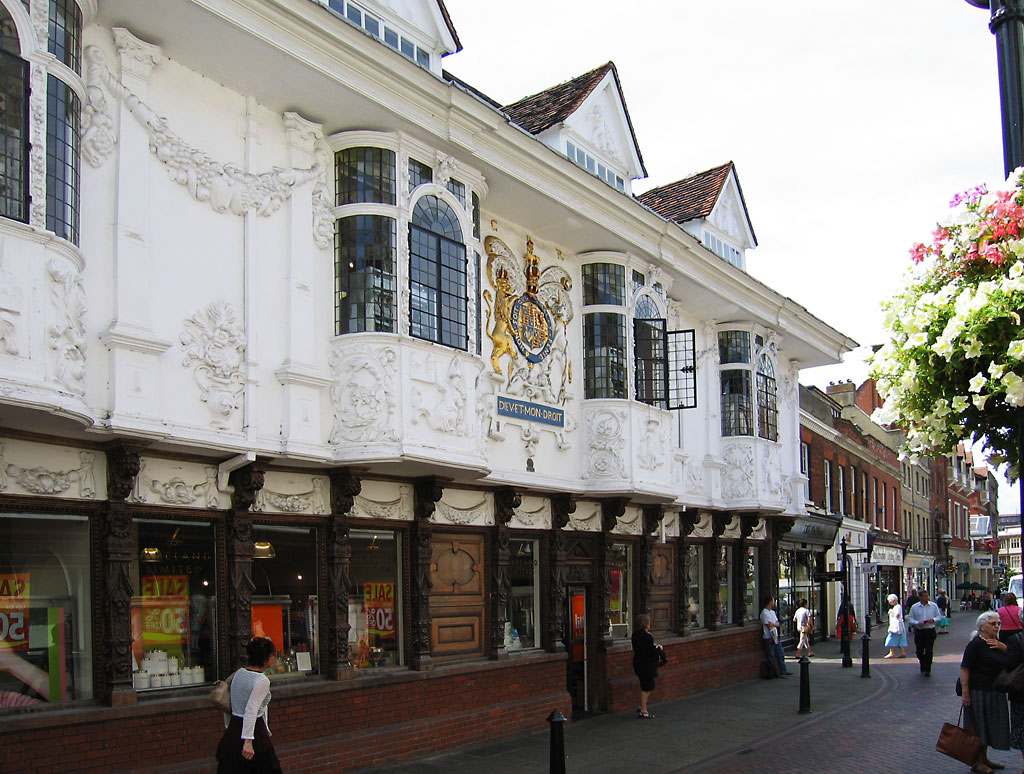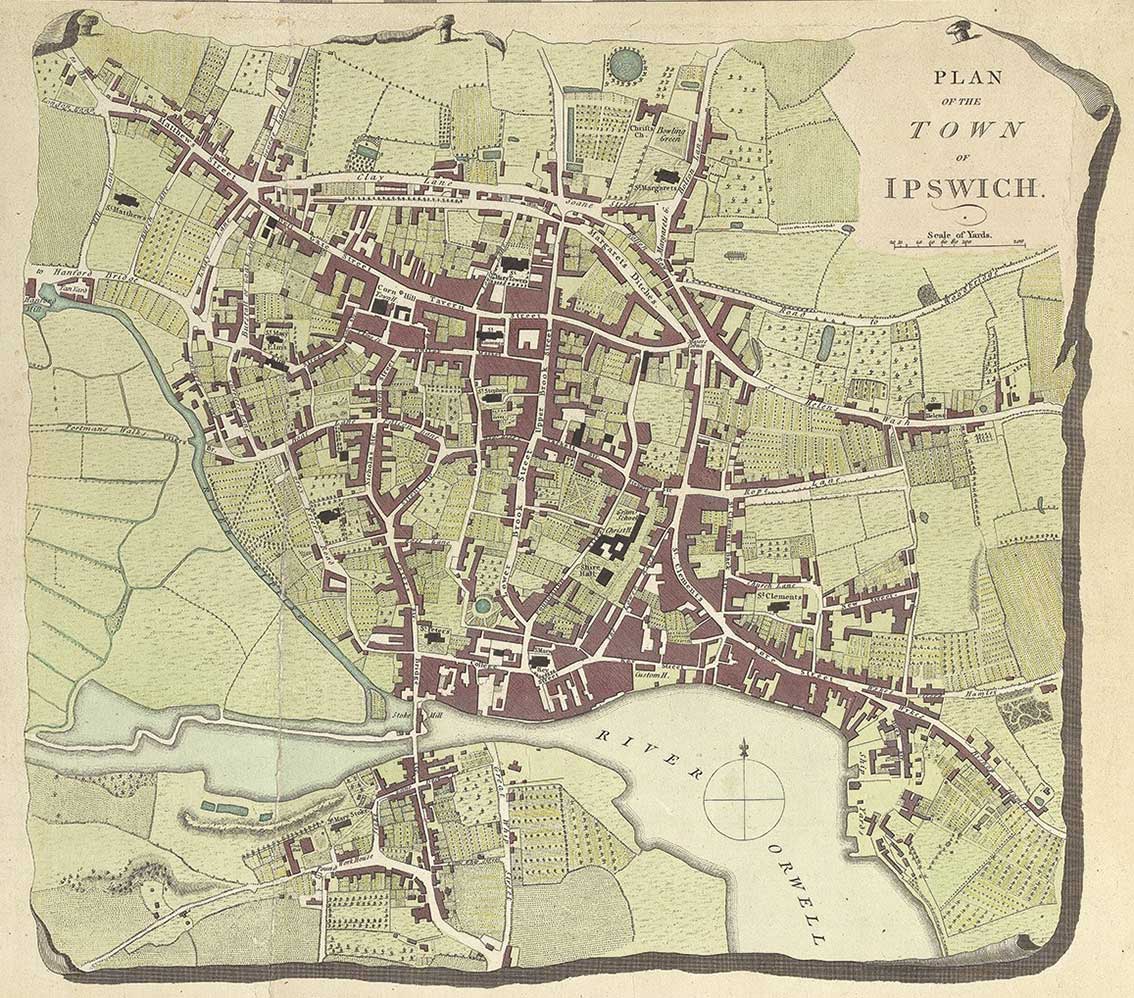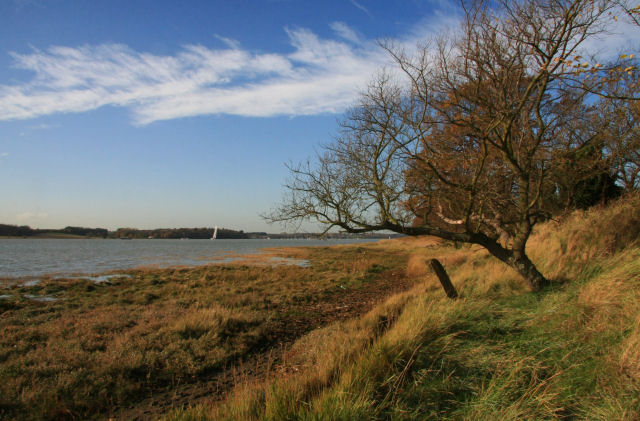|
St Peter's Church, Ipswich
St Peter's Church (also known as St Peter's by the Waterfront) is one of the twelve medieval churches in the ancient borough of Ipswich, England. An Augustinian priory dedicated to St Peter and Paul occupied a six-acre site to the north and east of the church. As the secular canons regularly used the chancel for religious purposes, leaving the nave for use of parishioners, the church was also known as St Peter and Paul's. The church is located between College Street and Star Lane, with St Peters Street leading north into Ipswich town centre. History The location is probably that of the earliest church building in Ipswich, there being a St Peter's church mentioned in the Doomsday book. The church was located just north of a ford by which visitors arriving in Ipswich could cross the River Orwell. On 8 January 1297, Edward I married his youngest daughter Elizabeth of Rhuddlan to John I, Count of Holland in this earlier church. The existing structure was built in 1460 and contains a ... [...More Info...] [...Related Items...] OR: [Wikipedia] [Google] [Baidu] |
Ipswich
Ipswich () is a port town and borough in Suffolk, England, of which it is the county town. The town is located in East Anglia about away from the mouth of the River Orwell and the North Sea. Ipswich is both on the Great Eastern Main Line railway and the A12 road; it is north-east of London, east-southeast of Cambridge and south of Norwich. Ipswich is surrounded by two Areas of Outstanding Natural Beauty (AONB): Suffolk Coast and Heaths and Dedham Vale. Ipswich's modern name is derived from the medieval name ''Gippeswic'', probably taken either from an Anglo-Saxon personal name or from an earlier name given to the Orwell Estuary (although possibly unrelated to the name of the River Gipping). It has also been known as ''Gyppewicus'' and ''Yppswyche''. The town has been continuously occupied since the Saxon period, and is contested to be one of the oldest towns in the United Kingdom.Hills, Catherine"England's Oldest Town" Retrieved 2 August 2015. Ipswich was a settlem ... [...More Info...] [...Related Items...] OR: [Wikipedia] [Google] [Baidu] |
Doomsday Book
Domesday Book () – the Middle English spelling of "Doomsday Book" – is a manuscript record of the "Great Survey" of much of England and parts of Wales completed in 1086 by order of King William I, known as William the Conqueror. The manuscript was originally known by the Latin name ''Liber de Wintonia'', meaning "Book of Winchester", where it was originally kept in the royal treasury. The ''Anglo-Saxon Chronicle'' states that in 1085 the king sent his agents to survey every shire in England, to list his holdings and dues owed to him. Written in Medieval Latin, it was highly abbreviated and included some vernacular native terms without Latin equivalents. The survey's main purpose was to record the annual value of every piece of landed property to its lord, and the resources in land, manpower, and livestock from which the value derived. The name "Domesday Book" came into use in the 12th century. Richard FitzNeal wrote in the '' Dialogus de Scaccario'' ( 1179) that the boo ... [...More Info...] [...Related Items...] OR: [Wikipedia] [Google] [Baidu] |
Ipswich Hospital Band
Ipswich () is a port town and borough in Suffolk, England, of which it is the county town. The town is located in East Anglia about away from the mouth of the River Orwell and the North Sea. Ipswich is both on the Great Eastern Main Line railway and the A12 road; it is north-east of London, east-southeast of Cambridge and south of Norwich. Ipswich is surrounded by two Areas of Outstanding Natural Beauty (AONB): Suffolk Coast and Heaths and Dedham Vale. Ipswich's modern name is derived from the medieval name ''Gippeswic'', probably taken either from an Anglo-Saxon personal name or from an earlier name given to the Orwell Estuary (although possibly unrelated to the name of the River Gipping). It has also been known as ''Gyppewicus'' and ''Yppswyche''. The town has been continuously occupied since the Saxon period, and is contested to be one of the oldest towns in the United Kingdom.Hills, Catherine"England's Oldest Town" Retrieved 2 August 2015. Ipswich was a settlement of g ... [...More Info...] [...Related Items...] OR: [Wikipedia] [Google] [Baidu] |
Heritage Lottery Grant
The National Lottery Heritage Fund, formerly the Heritage Lottery Fund (HLF), distributes a share of National Lottery funding, supporting a wide range of heritage projects across the United Kingdom. History The fund's predecessor bodies were the National Land Fund, established in 1946, and the National Heritage Memorial Fund, established in 1980. The current body was established as the "Heritage Lottery Fund" in 1994. It was re-branded as the National Lottery Heritage Fund in January 2019. Activities The fund's income comes from the National Lottery which is managed by Camelot Group. Its objectives are "to conserve the UK's diverse heritage, to encourage people to be involved in heritage and to widen access and learning". As of 2019, it had awarded £7.9 billion to 43,000 projects. In 2006, the National Lottery Heritage Fund launched the Parks for People program with the aim to revitalize historic parks and cemeteries. From 2006 to 2021, the Fund had granted £254million t ... [...More Info...] [...Related Items...] OR: [Wikipedia] [Google] [Baidu] |
Tournai Font
Tournai fonts are a type of baptismal font made from blue black limestone during the 12th and early 13th centuries in and around the Belgian town of Tournai by local masons. There are seven complete examples in England and a disputed number in Europe: eighty according to one source, or fifty in Northern France and Belgium and two in Germany according to another. A sculptural tradition, centred around Tournai, arose in the Scheldt valley from the 11th century onwards. This was characterised by its use of low relief (which was a useful feature when a sculpture was transported), hard lines and the depiction of minute detail, these features arising from the hardness of the material used from the 12th century; Tournai marble. As a sculptural style it is distinguished from the contemporary style of Mosan art, and it was used in sculpture in both Ghent and Bruges. The designation "Tournai font" is employed to identify fonts made by local masons who worked the stone, as opposed to at le ... [...More Info...] [...Related Items...] OR: [Wikipedia] [Google] [Baidu] |
John I, Count Of Holland
John I (1284 – 10 November 1299) was Count of Holland and son of Count Floris V. John inherited the county in 1296 after the murder of his father. Shortly after his birth, after negotiations between Floris and King Edward I of England in April 1285, he was betrothed to Elizabeth, a daughter of Edward and Eleanor of Castile. Soon after this the infant John was sent to England to be raised and educated there at Edward's court. In 1296, after the murder of John's father Count Floris V, King Edward invited a number of nobles from Holland with English sympathies, amongst whom were John III, Lord of Renesse, and Wolfert I van Borselen. On 7 January 1297 John married Edward's daughter Elizabeth at St Peter's Church, Ipswich. Soon after this, he was allowed to return to Holland, although being made to promise to heed the council of Renesse and Borselen. Elizabeth was expected to go to Holland with her husband, but did not wish to go, leaving her husband to go alone. After some delay ... [...More Info...] [...Related Items...] OR: [Wikipedia] [Google] [Baidu] |
Elizabeth Of Rhuddlan
Elizabeth of Rhuddlan (7 August 1282 – 5 May 1316) was the eighth and youngest daughter of King Edward I of England and Queen Eleanor of Castile. Of all of her siblings, she was closest to her younger brother King Edward II, as they were only two years apart in age. First marriage In April 1285 there were negotiations with Floris V for Elizabeth's betrothal to his son John I, Count of Holland. The offer was accepted and John was sent to England to be educated. On 8 January 1297 Elizabeth was married to John at Ipswich. In attendance at the marriage were Elizabeth's sister Margaret, her father, Edward I of England, her brother Edward, and Humphrey de Bohun. After the wedding Elizabeth was expected to go to Holland with her husband, but did not wish to go, leaving her husband to go alone. It is recorded that while in Ipswich the King, in some outburst, threw his daughter's coronet into the fire. A great ruby and a great emerald, stones supplied by Adam the Goldsmith, were lost ... [...More Info...] [...Related Items...] OR: [Wikipedia] [Google] [Baidu] |
Edward I
Edward I (17/18 June 1239 – 7 July 1307), also known as Edward Longshanks and the Hammer of the Scots, was King of England and Lord of Ireland from 1272 to 1307. Concurrently, he ruled the duchies of Aquitaine and Gascony as a vassal of the French king. Before his accession to the throne, he was commonly referred to as the Lord Edward. The eldest son of Henry III, Edward was involved from an early age in the political intrigues of his father's reign, which included a rebellion by the English barons. In 1259, he briefly sided with a baronial reform movement, supporting the Provisions of Oxford. After reconciliation with his father, however, he remained loyal throughout the subsequent armed conflict, known as the Second Barons' War. After the Battle of Lewes, Edward was held hostage by the rebellious barons, but escaped after a few months and defeated the baronial leader Simon de Montfort at the Battle of Evesham in 1265. Within two years the rebellion was e ... [...More Info...] [...Related Items...] OR: [Wikipedia] [Google] [Baidu] |
River Orwell
The River Orwell flows through the county of Suffolk in England from Ipswich to Felixstowe. Above Ipswich, the river is known as the River Gipping, but its name changes to the Orwell at Stoke Bridge, where the river becomes tidal. It broadens into an estuary at Ipswich, where the Ipswich dock has operated since the 7th century, and then flows into the North Sea at Felixstowe, the UK's largest container port, after joining the River Stour at Shotley forming Harwich harbour. The large Orwell Bridge carries the A14 trunk road over the estuary to the south of Ipswich. Name In the name ''Orwell'', ''Or-'' comes from an ancient river-name — probably pre-Celtic; but ''-well'' probably indicates an Anglo-Saxon naming. In ''A tour through England and Wales'', written in 1722, Daniel Defoe calls the river "Orwel" (though he does this inconsistently). He also mentions that "a traveller will hardly understand me, especially a seaman, when I speak of the River Stour and the River Or ... [...More Info...] [...Related Items...] OR: [Wikipedia] [Google] [Baidu] |
St Peter & Paul Priory, Ipswich
St Peter & Paul Priory, Ipswich was an Augustinian priory in Ipswich Suffolk, England. Foundation'Houses of Austin canons: Priory of St Peter and St Paul, Ipswich', in W. Page (ed.), ''A History of the County of Suffolk'' Vol. 2, ed. William Page (V.C.H., London 1975)pp. 102-03(British History Online, accessed 12 May 2018). The Priory of St Peter and St Paul was established in Ipswich in the 12th century. A list of religious houses of the late 12th century by Gervase of Canterbury names two priories of black canons in the town, this one and the Priory of the Holy Trinity, Ipswich. However, a reference relating to Henry I (died 1135) cites ‘my canons of my alms in Ipswich’ so one or both of these priories could date from the earlier part of this century. The Domesday Book indicates a church of St Peter in 1086 held by Aeschere with one acre. It is likely that both this and Holy Trinity are examples of existing churches that came to adopt Augustinian rule as Priories in ... [...More Info...] [...Related Items...] OR: [Wikipedia] [Google] [Baidu] |
Suffolk
Suffolk () is a ceremonial county of England in East Anglia. It borders Norfolk to the north, Cambridgeshire to the west and Essex to the south; the North Sea lies to the east. The county town is Ipswich; other important towns include Lowestoft, Bury St Edmunds, Newmarket, and Felixstowe which has one of the largest container ports in Europe. The county is low-lying but can be quite hilly, especially towards the west. It is also known for its extensive farming and has largely arable land with the wetlands of the Broads in the north. The Suffolk Coast & Heaths and Dedham Vale are both nationally designated Areas of Outstanding Natural Beauty. History Administration The Anglo-Saxon settlement of Suffolk, and East Anglia generally, occurred on a large scale, possibly following a period of depopulation by the previous inhabitants, the Romanised descendants of the Iceni. By the fifth century, they had established control of the region. The Anglo-Saxon inhabitant ... [...More Info...] [...Related Items...] OR: [Wikipedia] [Google] [Baidu] |
Augustinian Priory
Augustinians are members of Christian religious orders that follow the Rule of Saint Augustine, written in about 400 AD by Augustine of Hippo. There are two distinct types of Augustinians in Catholic religious orders dating back to the 12th–13th centuries: * Various congregations of Canons Regular also follow the Rule of Saint Augustine, embrace the evangelical counsels and lead a semi-monastic life, while remaining committed to pastoral care appropriate to their primary vocation as priests. They generally form one large community which might serve parishes in the vicinity, and are organized into autonomous congregations. * Several orders of friars who live a mixed religious life of contemplation and apostolic ministry. The largest and most familiar is the Order of Saint Augustine (OSA), founded in 1244 and originally known as the Hermits of Saint Augustine (OESA). They are commonly known as the Austin Friars in England. Two other orders, the Order of Augustinian Recollects an ... [...More Info...] [...Related Items...] OR: [Wikipedia] [Google] [Baidu] |







